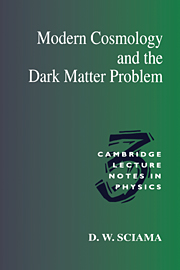Book contents
- Frontmatter
- Contents
- Preface
- Recent Developments
- Part One Dark Matter in Astronomy and Cosmology
- Part Two Ionisation Problems in Astronomy and Cosmology
- Part Three Neutrino Decay and Ionisation in the Universe
- Part Four Observational Searches for the Neutrino Decay Line
- 13 Observational Searches for the Neutrino Decay Line
- References
- Subject index
13 - Observational Searches for the Neutrino Decay Line
Published online by Cambridge University Press: 11 January 2010
- Frontmatter
- Contents
- Preface
- Recent Developments
- Part One Dark Matter in Astronomy and Cosmology
- Part Two Ionisation Problems in Astronomy and Cosmology
- Part Three Neutrino Decay and Ionisation in the Universe
- Part Four Observational Searches for the Neutrino Decay Line
- 13 Observational Searches for the Neutrino Decay Line
- References
- Subject index
Summary
Introduction
The evidence which has been accumulated in this book relating to our neutrino decay hypothesis is strong but circumstantial. It is crucially important to test the validity of the hypothesis by attempting to make a direct detection of the postulated radiation. Fortunately the kinematics of the decay imply that the emitted photons are monochromatic, so that the radiation from a given source, if strong enough to be detected, would show up as an unidentified line broadened by the velocity dispersion of the neutrinos in the source. Had the emission possessed a continuous spectrum it would have been much more difficult to distinguish it convincingly from radiation of a conventional origin.
Since the line is predicted to have an energy Eγ ∼ 15 eV, the problem of detectability is tied up with the high opacity of the interstellar medium for radiation of this energy. This problem is a natural one since the opacity is mainly due to the photoionisation of neutral hydrogen, the very process which originally led to the postulate that the decay radiation lies in this energy region. It does mean that care must be taken to choose a suitable observing target.
For example, a number of attempts were made to detect decay photons from dark matter in the Virgo and Coma clusters under the stimulus of the earlier neutrino decay theories of Cowsik (1977) and de Rujula and Glashow (1980). These attempts were made by Shipman and Cowsik (1981), Henry and Feldman (1981) and Holberg and Barber (1985).
- Type
- Chapter
- Information
- Modern Cosmology and the Dark Matter Problem , pp. 179 - 192Publisher: Cambridge University PressPrint publication year: 1994

